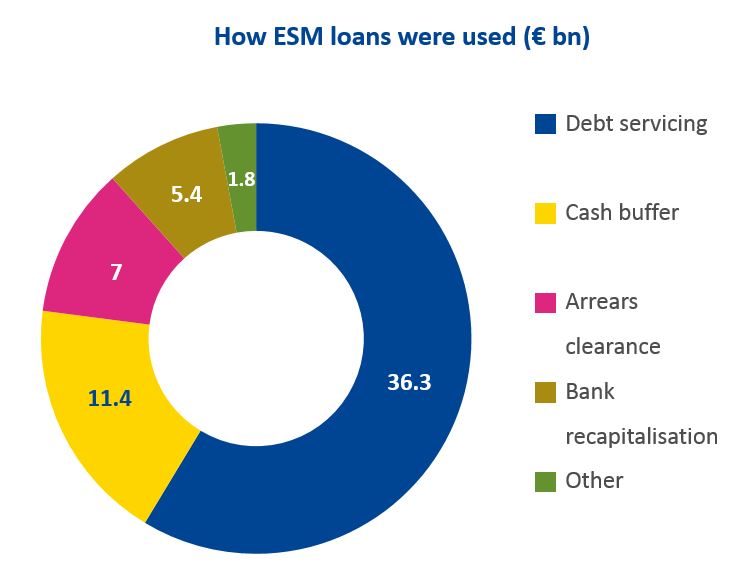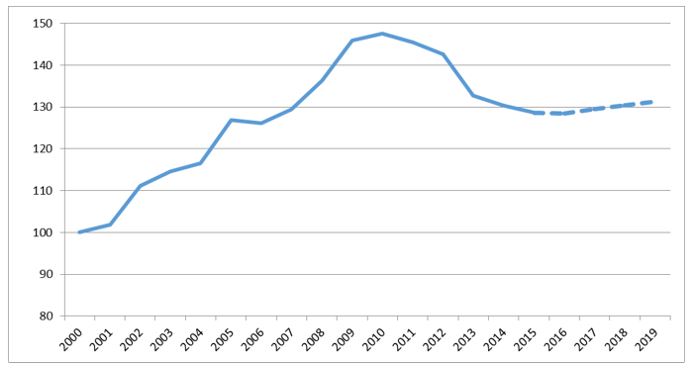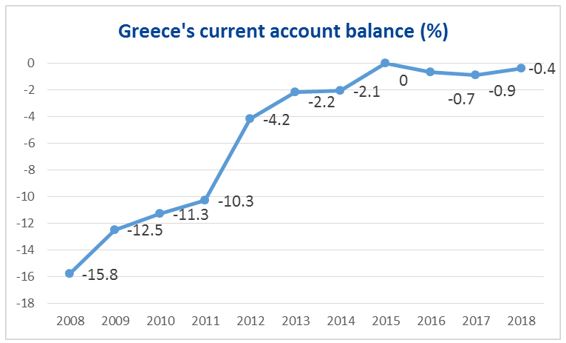
Greece
PROGRAMME TIMELINE FOR GREECE
2010
Greek government reveals that budget data had previously been misreported
Greek borrowing costs rise to unsustainable levels
Approval of 3-year joint financial assistance programme by euro area countries and IMF
2nd programme for Greece agreed, to be provided by EFSF and IMF
Yield on Greek 10-year bonds peaks at 33.7%; restructuring (53.5% haircut) of Greek government bonds held by banks
2011
2012
Greece’s economy starts growing after 6 years of decline
Greece returns to bond issuance for the first time in 4 years
New government announces major policy shift, halting previous reform agenda
Eurogroup leaders agree with Greece on new loan in exchange for reforms
ESM Board of Governors approves ESM programme for Greece ESM makes first loan disbursement of €13 bn to Greece
2013
2014
2015
2016
2017
2018
Programme overview
Greek Loan Facility (bilateral loans and IMF, 2010-2011)
EFSF and IMF programme (2012-2015)
ESM programme (2015-2018)
Lenders: EFSF: €141.8 billion; ESM: €61.9 billion; euro area countries (under GLF): €52.9 billion; International Monetary Fund (€32.1 billion).
Economic adjustment and reforms
Having adopted the euro in 2001, Greece was able to borrow at low interest rates despite its falling competitiveness and weak public finances. While government spending and borrowing increased, tax revenues weakened due to poor tax administration. Public debt soared and investor trust in Greece was seriously undermined. The Greek economy contracted sharply in 2008 and unemployment climbed to alarming levels. Furthermore, the country’s public administration was oversized and not sufficiently efficient. Greece had to rely on external financial assistance to continue financing its government debt.
During the first and second programmes, wide-ranging reforms were carried out to address Greece’s problems, and in 2014, the country recorded GDP growth for the first time since 2007 and unemployment began to fall. In the first half of 2015, Greece reneged on its reform commitments, and, as a consequence, the second programme was not completed and the country fell back into recession. The third programme enabled Greece to remain in the euro area as it returned to the implementation of much-needed reforms.
The financial assistance packages were tied to economic adjustment programmes, which focused on:
- Restoring fiscal sustainability;
- Safeguarding financial stability (bank recapitalisation; reduction of non-performing loans);
- Enhancing growth, competitiveness and investment (labour and product market reforms);
- Increasing the efficiency of public administration and the judicial system.
Thanks to the implementation of reforms, Greece was able to achieve an unprecedented fiscal adjustment from very high budget deficits in the early programme years to a surplus in 2017. In the same year, the country restored economic growth and regained market access. Important improvements and measures were introduced in the field of public administration; product, service and labour markets; pensions; tax administration; and the financial sector.
After the programme
Following the completion of Greece’s ESM programme in 2018, post-programme surveillance (PPS) has been carried out by the European Commission in liaison with the European Central Bank. The procedure involves regular review missions in the programme country to assess its economic, fiscal, and financial situation. The ESM participates in PPS missions to fulfil the requirements of its Early Warning System, i.e. to assess a country’s capacity to repay its outstanding loans.
Greece’s continued to modernise its economy, strengthen its banks, reduce imbalances, and boost competitiveness. As a result, the Greek economy was structurally more resilient at the start of the pandemic than it was prior to the sovereign debt crisis. Past reforms, though quite painful at times, enabled the country to mount a vigorous response to the pandemic. In part because of the fiscal support, Greece experienced a rapid recovery from the pandemic.
Greece completed the repayment of IMF loans ahead of schedule in April 2022.
ESM country team coordinator for Greece: Paolo Fioretti
ESM Disbursements to Greece
| Date of disbursement | Amount disbursed | Type of disbursement | Maturity | Cumulative amount disbursed |
|---|---|---|---|---|
| 20/08/2015 | €13 billion | Cash | Amortisation from 2034 to 2057 | €13 billion |
| 24/11/2015 | €2 billion | Cash | Amortisation from 2034 to 2057 | €15 billion |
| 01/12/2015 | €2.7 billion | Cashless | Amortisation from 2055 to 2059 | €17.7 billion |
| 08/12/2015 | €2.7 billion | Cashless | Amortisation from 2055 to 2059 | €20.4 billion |
| 23/12/2015 | €1 billion | Cash | Amortisation from 2034 to 2057 | €21.4 billion |
| 21/06/2016 | €7.5 billion | Cash | Amortisation from 2034 to 2058 | €28.9 billion |
| 26/10/2016 | €2.8 billion | Cash | Amortisation from 2034 to 2058 | €31.7 billion |
| 10/07/2017 | €7.7 billion | Cash | Amortisation from 2034 to 2059 | €39.4 billion |
| 30/10/2017 | €0.8 billion | Cash | Amortisation from 2034 to 2059 | €40.2 billion |
| 28/03/2018 | €5.7 billion | Cash | Amortisation from 2051 to 2054; 2060 | €45.9 billion |
| 15/06/2018 | €1 billion | Cash | Amortisation from 2034 to 2060 | €46.9 billion |
| 06/08/2018 | €15 billion | Cash | Amortisation from 2043 to 2060 | €61.9 billion |
Weighted average maturity of loans: 32.35 years (after repayment of €2 billion).
Floating rate notes issued by the ESM1
| ISIN | Issuance date | Maturity | Type | Amount |
|---|---|---|---|---|
| EU000A1U9852 | 27/08/2015 | 27/02/2017 | FRN | €3 billion |
| EU000A1U9860 | 27/08/2015 | 27/08/2017 | FRN | €3 billion |
| EU000A1U9878 | 27/08/2015 | 27/02/2018 | FRN | €4 billion |
1 The ESM issued floating rate notes for the purposes of funding bank recapitalisation/resolution. Notes amounting to €5.4 billion were disbursed to Greece; the remaining €4.6 billion was not used and the notes were subsequently cancelled. The amount was disbursed pro rata in ESM floating rate notes listed above.
Loan repayment
| Date of repayment | Amount repaid | Details |
|---|---|---|
| 20/02/2017 | €2 billion | Contractual obligation following sale of assets of recapitalised NBG bank |
Previous financial assistance for Greece
Euro area Member States provided the first financial assistance package to Greece, supplying €52.9 billion in bilateral loans under the Greek Loan Facility. EFSF financial assistance, part of the second programme, ran from March 2012 through June 2015. In this programme, the EFSF disbursed a total of €141.8 billion, of which €130.9 is outstanding.
More details about EFSF financial assistance for Greece
Facts
Explainer
Greece made major efforts to implement wide-ranging reforms, which were tied to the first financial assistance package. The challenges confronting Greece remained significant, however, with a wide competitiveness gap, a large fiscal deficit, a high level of public debt, and an undercapitalised banking system. The economic recession in Greece proved to be more serious and damaging than expected. The financial assistance provided under the first programme was not sufficient for Greece to make the necessary adjustments and to regain market access.
Furthermore, Greece’s public debt was considered unsustainable. A restructuring of debt held by private creditors became necessary to bring the total debt level back to a sustainable path. Additional time and funds were required to Greece’s fiscal consolidation efforts with structural reforms, to boost growth, and improve competitiveness. Therefore, a second programme for Greece, provided by the EFSF and IMF, was decided in February 2012.
Although Greece’s achievements in rebounding from a deep crisis have been remarkable, significant challenges remain. Efforts must continue to liberalise the economy, create an effective public administration, as well as a business-friendly environment. Unemployment remains very high (19.5% in May 2018), and sustainable growth is the only way for Greece to deliver more jobs and prosperity for its people.
Greece needs to build upon the progress achieved under the ESM programme and strengthen the foundations for a sustainable recovery, notably by continuing and completing reforms launched under the programme. In an annex to the Eurogroup statement of 22 June 2018, the Greek government committed to ensure the continuity and completion of reforms in several key areas:
- Fiscal and structural (primary surplus of 3.5% of GDP over the medium-term)
- Social welfare (modernising pension and health care systems)
- Financial stability (continued reforms aimed at restoring the health of the banking system, including NPL resolution)
- Labour and product markets (action plan on undeclared work; investment licensing reform; completing the cadastre project)
- Hellenic Corporation of Assets and Participations (HCAP) and privatisation (asset development plan; completing key transactions)
- Public administration (modernising human resource management in the public sector; new labour law code; implementing anti-corruption recommendations).
Since 2010, Greece has carried out a comprehensive range of reforms, which can be grouped into four areas (the most important examples are listed):
- Restoring the sustainability of public finances
- Personal income tax system revised
- VAT system streamlined for general efficiency and to reduce scope for fraud
- Unsustainable and fragmented pension system overhauled
- Safeguarding financial sustainability
- Governance of Greek systemic banks strengthened and brought in line with international best practice
- Structure of household and corporate insolvency legislation reviewed
- Reduction in stock of non-performing loans (NPLs)
- Structural policies to enhance growth, competitiveness and investment
- Labour market reforms – improved system of collective bargaining
- Product markets – reducing unnecessary barriers, lifting restrictions in regulated professions
- New independent fund (HCAP) for better management, improved service provision, and monetisation of key State assets
- Energy market for gas and electricity has been opened
- The functioning of Greece’s public sector
- Size of public sector reduced by 25% between 2009 and 2017
- Annual performance assessments for all public officials; competitive selection of senior management
- Reforms improving efficiency of judicial system
The ESM and EFSF have provided loans to Greece at much lower interest rates and with exceptionally long maturities compared to those that the market would offer. These favourable lending terms have generated considerable budgetary savings, facilitating fiscal consolidation and/or tax cuts. The amount of savings is calculated by comparing the effective interest rate payments on ESM and EFSF loans with the interest payments Greece would have paid had it covered its financing needs in the market. In 2017 the savings amounted to €12 billion, or 6.7% of Greek GDP. The savings take effect at similar level every year.
With a combined €190.8 billion in outstanding loans to Greece, the EFSF and the ESM are by far the country’s largest creditors. This is an amount higher than Greece’s projected GDP in 2018. The rescue funds together hold a total 55.5% of Greek central government debt.
In order to ensure that Greece and other beneficiary countries repay their loans, the ESM is obliged by the ESM Treaty to carry out its own monitoring, called the Early Warning System(EWS), until the loans have been repaid in full. This requires an assessment of the country’s short-term liquidity, market access, and the medium- to long-term sustainability of public debt.
The European Commission activated the Enhanced Surveillance framework, which implies quarterly reports of the Commission to assess its economic, fiscal and financial situation and the post-programme policy commitments. Enhanced surveillance is appropriate due to the large amount of money disbursed by the EFSF/ESM and the unprecedented debt relief. The ESM will closely collaborate with the Commission in the post-programme phase in the context of its Early Warning System.
Greece has committed to maintain a primary surplus (a national government’s budget surplus excluding interest payments on its outstanding debt) of 3.5% of GDP until 2022 and, thereafter to ensure that its fiscal commitments are in line with the EU fiscal framework (around 2%).
Further commitments are described in What challenges does Greece still face?
Due to political uncertainty and fear of a Greek euro exit, deposit holders withdrew significant funds from Greek banks in 2015, and the banks experienced an increase in payment delays as borrowers waited to see whether the government would introduce debt relief measures.
Under the programme, the ESM committed up to €25 billion to Greece to address potential bank recapitalisation and resolution costs. In December 2015, the ESM disbursed a total of €5.4 billion to the Greek government for the recapitalisation of Piraeus Bank and NBG.
The chart below provides a breakdown of how the ESM loans were used by Greece:

The ESM disbursed a total of €61.9 billion, out of a maximum programme volume of €86 billion. The unused amount mainly derives from the substantially lower recapitalisation needs of banks compared to what was originally foreseen (€5.4 billion used out of a maximum amount of €25 billion) and from more efficient management of cash resources by the Greek government.
It should be noted that in the ESM programmes for Spain and Cyprus, the amount disbursed was also lower than the maximum amount available under their respective programmes.
The implementation of an ambitious growth strategy and prudent fiscal policies by the Greek government will be the key ingredients for debt sustainability. Through its long-term growth plan, Greece is committed to preserving its programme achievements, which includes completing the reforms that were enacted under the programme and continuing to implement further reforms designed to boost its growth potential.
In addition, the Greek government has committed to maintaining a primary surplus of 3.5 % of GDP until 2022, and around 2% in following years to continue to ensure that its fiscal commitments are in line with the EU fiscal framework.
Finally, the medium-term debt measures agreed by the Eurogroup, together with the significant cash buffer available to the Greek government, will provide strong support for Greece’s efforts. The European institutions’ Debt Sustainability Analysis, DSA, indicates that Greece’s gross financing needs are expected to remain below 15% of GDP over the medium term and to comply with the 20% threshold in the long run, and that Greece’s debt is therefore considered sustainable.
For the long-term, the Eurogroup also agreed to review at the end of the EFSF grace period in 2032, whether additional debt measures are needed to ensure the respect of these gross financing needs targets. However, additional measures can only be considered if Greece continues to respect the EU fiscal framework.
Greece will repay the ESM loans from 2034 to 2060. In November 2018, the EFSF Board of Directors approved a set of medium-term debt relief measures for Greece, which included an extension of the maximum weighted average maturity by 10 years on €96.4 billion of EFSF loans to Greece. Consequently, in April 2019, after a re-profiling of the EFSF loans to Greece, the current repayment period for the EFSF loans is from 2023 to 2070. (see detailed information on the repayment of EFSF loans)
The extent of underlying economic problems at the beginning of the crisis in Greece was much greater than in other ESM/EFSF programme countries. Having adopted the euro in 2001, Greece was able to borrow at low interest rates despite its falling competitiveness and weak public finances. While government spending and borrowing increased, tax revenues weakened due to poor tax administration. Public debt soared quickly and investor trust in Greece was seriously undermined. The Greek economy contracted sharply (nearly 30% from 2008 to 2016) and unemployment climbed to alarming levels. Furthermore, the country’s administration was weaker than in other euro area countries. The public sector was oversized and its efficiency was well below European standards.
During the first and second programmes (bilateral loans from the other euro area countries known as the Greek Loan Facility or GLF from 2010-2011; EFSF programme from 2012-2015), wide-ranging reforms were carried out to address Greece’s problems, and in 2014, the country recorded GDP growth for the first time since 2007 and unemployment began to fall. In the first half of 2015, the country reversed very important reforms. There was an attempt to halt the reform programme Greece had agreed to. The result was that the country dropped back into recession. The third programme, agreed with the ESM in August 2015, enabled Greece to remain in the euro area in return for implementing a series of much-needed reforms. After three years, on 20 August 2018, Greece successfully completed the ESM programme. As of this date, the country is no longer reliant on ongoing external rescue loans for the first time since 2010.
- smoothing Greece’s repayment profile;
- reducing interest rate risk;
- waiving the step-up interest rate margin for 2017
The first is a bond exchange. To recapitalise banks, the EFSF/ESM provided loans to Greece worth a total of €42.7 billion. These loans were not disbursed in cash, but in the form of floating-rate notes. Greece used the notes to recapitalise banks.
The ESM is now exchanging these bonds for fixed-rate notes, which it is then buying back for cash. This significantly reduces the interest rate risk that Greece bears. The ESM has raised all the funds that are needed for the bond exchange through issuing longer-dated bonds.
The second scheme foresees the ESM entering into swap arrangements. This scheme aims at stabilising the ESM’s overall cost of funding and reducing the risk that Greece would have to pay a higher interest rate on its loans when market rates start rising.
A swap is a financial contract that enables two counterparties to exchange the cash flow on two different securities, for instance, fixed-rate payments for floating-rate payments.
The ESM has now put the swap programme in place, and will continue to be active in the derivatives markets to maintain it.
The third scheme, known as matched funding, foresees the ESM charging a fixed rate on part of future disbursements to Greece. This would entail issuing long-term bonds that closely match the maturity of the Greek loans. This scheme will be implemented in 2018.
Market conditions may influence the degree to which the ESM can implement any of these three schemes.
For internal purposes, the ESM has created a portfolio that will contain the proceeds of all the operations required to fund the short-term measures, known as the ‘Greek Compartment’. This will enable us to isolate these costs, and pass them on directly to Greece, so that other beneficiary countries don’t bear any extra cost.
The adjusted repayment profile is expected to bear no cost. The cost of the waiver of the step-up margin will consist of the foregone profit for the EFSF and its shareholders.
Any costs from the three schemes to reduce the interest rate risk will be borne by Greece. This is particularly the case for the bond exchange and the interest rate swaps. Such short-term costs are more than compensated by the long-term benefits of the operation for Greece.
When implemented in full, these measures should lead to a cumulative reduction of Greece’s debt-to-GDP ratio of around 25 percentage points until 2060, according to ESM estimates in a baseline scenario. It is also expected that Greece’s gross financing needs will fall by around six percentage points over the same time horizon. The bond exchange and the interest rate swaps make up the largest part of this reduction. Second-round effects on Greece’s refinancing rates would be an additional benefit. The short-term measures will improve Greece’s debt sustainability.
However, caution is warranted. The impact of some of the measures hinges on several factors beyond the ESM’s control. These include the interest rate environment and the availability of other market participants to conclude some transactions.
The ministers said that these measures would be implemented after the closure of the first review and before the end of the current ESM programme (the third programme). On 5 December 2016, the ESM presented detailed plans for the short-term measures to the Eurogroup.
On January 23, the governing bodies of the ESM and of the EFSF completed the approval process of the measures. The measures were successfully implemented over the course of 2017.
The Greek Loan Facility is the first financial support programme for Greece, agreed in May 2010. It consisted of bilateral loans from euro area countries, amounting to €52.9 billion, and a €20.1 billion loan from the IMF. The EFSF, which was only established in June 2010, did not take part in this programme.
The Eurogroup agreed a set of measures designed to ease Greece’s debt burden and bring its public debt back to a sustainable path. These measures included:
- reducing the interest rate charged to Greece on the bilateral loans in the context of the Greek Loan Facility (GLF) by 100 basis points;
- cancelling the EFSF guarantee commitment fee of 10 basis points (it is estimated that this will save a total of €2.7 billion over the entire period of EFSF loans to Greece);
- extending the maturity of GLF loans by 15 years to 30 years (to 2041); extending the EFSF weighted average maturities by 15 years to 32.5 years, thus significantly improving the country’s debt profile;
- deferring interest rate payments on EFSF loans by 10 years until the end of 2022 (it is estimated that this will lower the country’s financing needs by €12.9 billion);
- passing on to Greece an amount equivalent to the income of the ECB’s Securities Markets Programme (SMP) portfolio accruing to their national central bank.
Greece has managed to significantly reduce its macroeconomic and fiscal imbalances. An unprecedented fiscal adjustment has resulted in a decline of the general government deficit by roughly 16 percentage points of GDP, to a surplus of 0.8% in 2017 from a deficit of 15.1% in 2009. Economic growth has returned as the recovery has begun to take hold, rebounding from -5.5% in 2010 to 1.4% in 2017. The Greek economy has improved its competitiveness by reducing unit labour costs.
Nominal unit labour costs in Greece (2000=100)
Source: European Commission
The improvement can also be seen in the falling current account deficit: to -0.4% in 2018 from -15.8% in 2008.
Greece’s current account balance 2007-2018
Source: European Commission
In 2010 unemployment was at 12.7%. After reaching a peak of 27.5% in July 2013, it has now decreased to 19.5% in May 2018. While unemployment is still the highest among all EU countries, labour market conditions continue to improve. The reduction in 2017 was the greatest single year decline since the peak in 2013. More than 100,000 new jobs have been created since the start of the ESM programme in 2015.
Yes. Before the capital raising, the banks’ bondholders and holders of preferred shares voluntarily exchanged their securities for equity capital. Another option for the banks was to sell units or wind down non-core business. These measures enabled all four systemic Greek banks to meet their capital shortfalls under the baseline scenario.
Two of the banks, Alpha Bank and Eurobank, raised enough capital to also meet the adverse scenario; they did not require further funds. Piraeus Bank and NBG required additional state aid through the Hellenic Financial Stability Fund (HFSF), which is funded by loans from the ESM.
Also known as the PSI (private sector involvement) or private sector haircut, it was a restructuring of Greek debt held by private investors (mainly banks) in March 2012 to lighten Greece’s overall debt burden. About 97% of privately held Greek bonds (about €197 billion) took a 53.5% cut of the face value (principal) of the bond, corresponding to an approximately €107 billion reduction in Greece’s debt stock.
The EFSF encouraged bondholders to participate in the restructuring. It provided EFSF bonds as part of two facilities to Greece. These were the:
- PSI facility – as part of the voluntary debt exchange, Greece offered investors 1- and 2-year EFSF bonds. These EFSF bonds, provided to holders of bonds under Greek law, were subsequently rolled over into longer maturities.
- Bond interest (accrued interest) facility – to enable Greece to repay accrued interest on outstanding Greek sovereign bonds under Greek law which were included in the PSI. Greece offered investors EFSF 6-month bills. The bills were subsequently rolled over into longer maturities.
Greece has received a total of €288.7 billion in rescue loans since 2010. The details are shown below:
Euro area, EFSF/ESM and IMF assistance for Greece
| Financial assistance programmes for Greece | Disbursed (€ billion) | |
| 1st programme | GLF (euro area) IMF Total |
52.9 20.1 73.0 |
| 2nd programme | EFSF IMF Total |
141.8 12.0 153.8 |
| 3rd programme | ESM | 61.9 |
| Total from euro area, EFSF and ESM Total from IMF Total loans disbursed |
256.6 32.1 288.7 |
|
The total amount disbursed by the EFSF and the ESM to Greece is €203.7 billion.
The EFSF disbursed €141.8 billion in loans to Greece from 2012 to 2015. The EFSF programme was part of the second programme for Greece. The IMF contributed €12 billion in loans under the programme.
After Greece adopted the euro in 2001, it was able to borrow at much lower interest rates despite its deteriorating competitiveness and public finances. In the decade before the crisis, Greece was able to use this cheap funding to finance a deficit which grew to unsustainable levels. Conditions in the euro area during this period facilitated such lending, despite the build-up of the unsustainable deficit. This meant that Greece could delay difficult structural reforms that had become necessary and may have been unavoidable if cheap funding had not been available during the 2000s.
While government spending and borrowing increased, tax revenues weakened due to poor tax administration. At the same time, wages rising much faster than productivity growth undermined Greece’s competitiveness, while low productivity and existing and significant structural problems also contributed to the increasing economic difficulties. As a result, Greece’s economy contracted and unemployment began to climb to alarming levels.
Greece’s reliance on external financing for funding budget and trade deficits left its economy very vulnerable to shifts in investor confidence. In 2009, the Greek government revealed that previous governments had been misreporting government budget data. Much higher-than-expected deficits eroded investor confidence, causing the yields on Greek sovereign bonds (which correspond to the cost of borrowing money) to rise to unsustainable levels. The situation worsened to the point where the country was no longer able to refinance its borrowing, and it was forced to ask for help from its European partners and the IMF.
Further information and related content
- European Commission's Ex-Post Evaluation of the Economic Adjustment Programmes of Greece, 2010-2018
- Post-Programme Surveillance Report. Spring 2023
- Post-Programme Surveillance Report, Autumn 2022
- European Commission Enhanced Surveillance Report - February 2020
- European Commission Enhanced Surveillance Report - June 2019
- European Commission Enhanced Surveillance Report - November 2018
- Memorandum of Understanding
- Supplemental MoU (June 2018)
- Supplemental MoU (March 2018)
- Supplemental MoU (Jan 2018)
- Technical MoU (Jan 2018)
- Supplemental MoU (July 2017)
- Compliance Report - 4th Review of ESM programme (July 2018)
- Compliance Report - 3rd Review of the ESM programme (March 2018)
- The ESM Stability Support Programme for Greece, First and Second Reviews - July 2017 Background report
- Compliance Report - 2nd review of the ESM programme (June 2017)
- Compliance Report: The Third Economic Adjustment Programme for Greece - First Review (June 2016)
- Staff statement following the third post-programme mission to Greece
- EFSF approves reimbursement and reduction of step-up interest margin for Greece
- Joaquín Almunia to lead ESM evaluation on financial assistance to Greece
- Staff statement following the second post-programme mission to Greece
- Approval of medium-term debt relief measures for Greece
- Staff statement following the first post-programme mission to Greece






